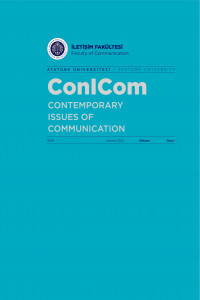Dijital Manipülasyonun Yapay Zekâ Boyutu Deepfake Videolar: Ukrayna -Rusya Halkı Örneği
Dijital Manipülasyon, Yapay Zekâ, Deepfake Videolar, Ukrayna-Rusya Halkı, Dezenformasyon
The Artificial Intelligence Dimension of Digital Manipulation Deepfake Videos: The Case of the Ukrainian-Russian People
Digital Manipulation, Artificial Intelligence, Deepfake Videos, Ukrainian-Russian People, Disinformation,
___
- Aydin, K. (2022). The use of digital manipulation in virtual images as an alternative tool to stimulate consciousness [Unpublished master thesis] Ondokuz Mayıs University, Institute of Graduate Studies.
- Berk, M. E. (2020). “The New Danger of The Digital Age Is "Deepfake"”. OPUS International Journal of Society Research, 16 (28), 1508-1523.
- Çolak, B. (2021). Legal Issues of Deepfakes. Institute for Internet and the Just Society. https://www.internetjustsociety.org/legal-issues-of-deepfakes [Access Date: 17.09 .20 23].
- De Ruiter, A. (2021). “The Distinct Wrong of Deepfakes”. Philosophy & Technology. 34(4). 1311-1332.
- Elitas, T. (2022). “Digital Manipulation Is The 'Deepfake' Technology And The Credibility Of The Non-Existent”. Hatay Mustafa Kemal University Journal of Social Sciences Institute. 19(49). 113-128.
- Fox61 Web. (2022). Fact-checking if the video of Ukrainian President Zelenskyy urging surrender is real. https://www.fox61.com/video/news/verify/fact-checking-if-the-video-of-ukrainian-president-zelenskyy- urging-surrender-is-real/536-c44aa30c-0da2-4d93-8430-5494218e2d37 [Access Date: 17.09 .20 23].
- Gov.Uk. (2019). Independent report snapshot paper - deepfakes and audiovisual disinformation. https://www.gov.uk/government/publications/cdei-publishes-its-first-series-of-three-snapshot-papers- ethical-issues-in-ai/snapshot-paper-deepfakes-and-audiovisual-disin formation [Access Date: 17.09.2023].
- Göngen, M.A., Kesgin, Y., (2023). Yeni Medya Araştırmaları Dil, İmaj, Fenomenler, Teknoloji, Dezenformasyon. Özgür Publications. DOI: https://doi.org/10.58830/ozgur.pub63. License: CC-BY-NC 4.0
- Google Trends. (2022). Historical process of searches for deepfake videos. https://trends.google.com/trends/ [Access Date: 10.02.2023].
- Heo, Y. J., Yeo, W. H., and Kim, B. G. (2023). “Deepfake Detection Algorithm Based On Improved Vision Transformer”. Applied Intelligence. 53(7). 7512-7527.
- Hybrid Media. (2021). What is manipulation and how is it done? https://hibritmedya.com.tr /what-is- manipulation-how-to-do [Access Date: 17.09.2023].
- Khashoggi, F. (2017). "A Study in Ethnomethodology". Journal of Social Science.June 11(21).161-168.
- Kitzinger, J. (1995). “Qualitative Research: Introducing Focus Groups”. Bmj. 311(7000), 299-302. Kvale, S. (1994). Interviews: An introduction to qualitative research interviewing. Sage Publications, Inc.
- Taşcıoğlu, R. (2010). “Reading Hilmi Ziya Ülken in The Context of Her Contribution To Communication Science in Turkey”. Journal of communication theory & research, (1), 1-12.
- Van der Sloot, B., and Wagensveld, Y. (2022). “Deepfakes: Regulatory Challenges For The Synthetic Society.” Computer Law & Security Review. 46. 105716. https://doi.org/10.1016/j.clsr.2022. 105716.
- Whittaker, L., Mulcahy, R., Letheren, K., Kietzmann, J., and Russell-Bennett, R. (2023). “Mapping the Deepfake Landscape For Innovation: A Multidisciplinary Systematic Review And Future Research Agenda”. Technovation. 125. 102784.
- Wikipedia. (2022). Where is Yakutia? https://tr.wikipedia.org/wiki/Yakutistan#:~:text =Saha %20uzak%20north%20Henrietta%20Adas%C4%B1na,Saha%20Republic%20toprak%C4%B1n%C4%B1n%20bir%20 par%C3%A7as %C4%B1d%C4%B1r [Access Date: 17.09.2023].
- Yildirim, B. (2015). Historical development of the content analysis method, areas of application and stages. B. Yildirim (Der.). Methods in communication research: with applications and examples (pp. 105-155), Konya: Literaturk Akademia.
- Başlangıç: 2022
- Yayıncı: Atatürk Üniversitesi
Cinema Literary Adaptations as a Narrative Form
Dijital Manipülasyonun Yapay Zekâ Boyutu Deepfake Videolar: Ukrayna -Rusya Halkı Örneği
Photography in the Context of Installation and Dimensionality
A Review on the Social Media Postings of Clothing Brands Related to the February 2023 Earthquake
Interview with Prof. Dr. Meriç Hızal About Art
Fashion as a Concept that Designs and Consumes the Body
The Relationship Between Photography and Propaganda: The Case of Lisa Kristine
